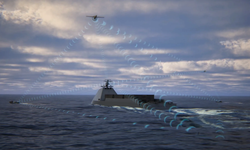3D printing has become an integral part of modern defense manufacturing, moving from design labs to the battlefield. Militaries are now exploring mobile production units to produce critical equipment in operational environments. The French Army has recently begun testing a mobile micro factory designed to manufacture FPV drones directly on the front lines, underscoring the growing role of additive manufacturing in combat support.
An earlier example of this trend came in 2022, when the Royal Dutch Navy worked with 3D printing company UltiMaker and polymer specialist Covestro (acquired by Stratasys in 2023) to test the limits of printed components. The question posed was straightforward: how strong can a 3D-printed part be?Instead of relying solely on conventional tensile testing, the partners opted for a full scale demonstration. Engineers designed a carbon fiber reinforced nylon link that would connect lifting equipment with heavy military vehicles. Covestro’s Addigy F1030 CF10 material was selected for its strength and ability to absorb sudden peak forces.
UltiMaker Application Engineer Lars de Jongh, who developed the design, explained that stability and force alignment were crucial. “The link needed a flat side for reliable printing, and the layer lines had to follow the same direction as the forces applied on the part,” he said. He added that maximizing the contact surface between the printed part and the steel rings was essential to distribute stress evenly and avoid weak points.Before printing, the team relied heavily on simulations. According to de Jongh, digital modeling not only helped optimize the geometry but also allowed engineers to remove unnecessary material without compromising performance. “By simulating the actual properties of the carbon fiber nylon, we could predict how the link would behave under real-world stress,” he noted.

Two versions of the link were produced: a one kilogram design estimated to withstand 12 tonnes, and a two kilogram version projected to hold more than three times that weight. Both underwent tensile testing at the Navy’s facilities, where the results closely matched computer predictions with an error margin of only one percent.
The final test took place at a Dutch Army base. As a preliminary trial, the smaller link lifted a two-tonne military jeep. The larger version was then used with Rheinmetall's “Buffalo” recovery vehicle based on the proven Leopard 2 chassis to hoist an M113 armored vehicle weighing 12 tonnes. The 3D-printed component held firm as the armored vehicle was raised and maneuvered.
For engineers involved, the trial also highlighted lessons beyond raw strength. De Jongh pointed to the impact of material handling, noting that nylon’s tendency to absorb moisture can affect print quality. Ensuring dried spools and controlled print environments, he said, was just as important as design optimization.
The case showed that 3D printing can go beyond prototyping and into roles demanding real strength and reliability. With armies now integrating mobile 3D production for drones and other equipment, the Dutch Navy’s experiment illustrates how far the technology has advanced in defense.













